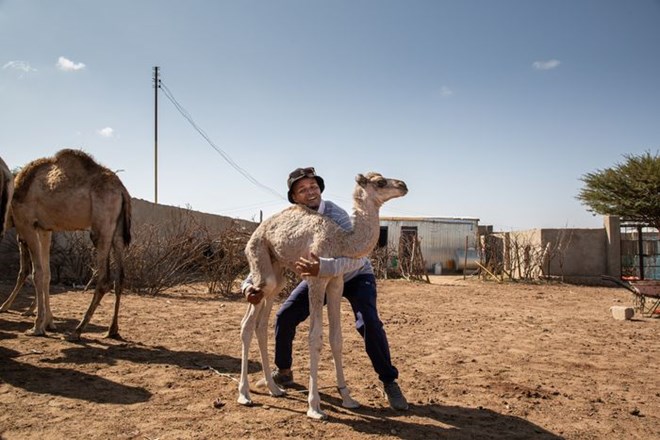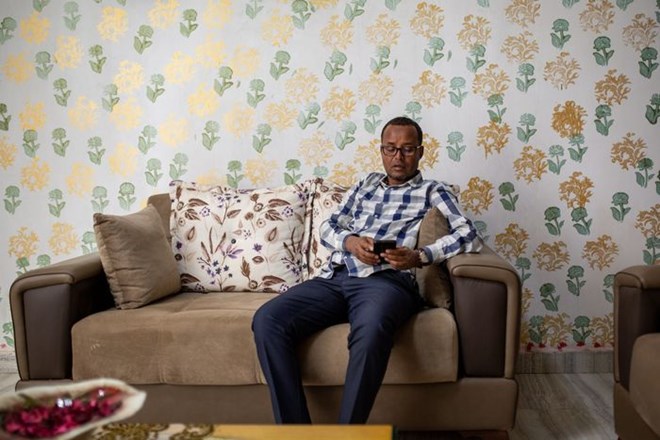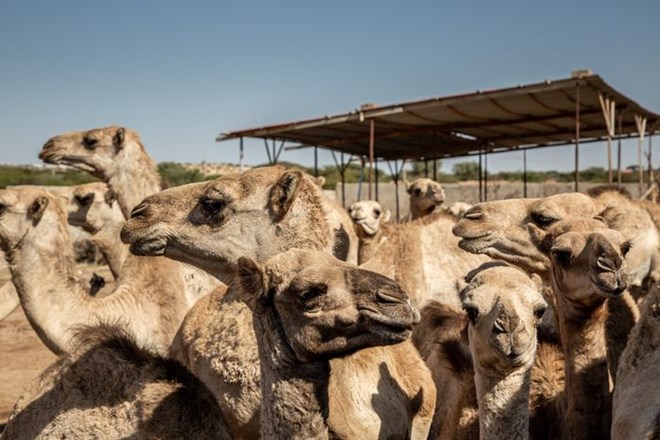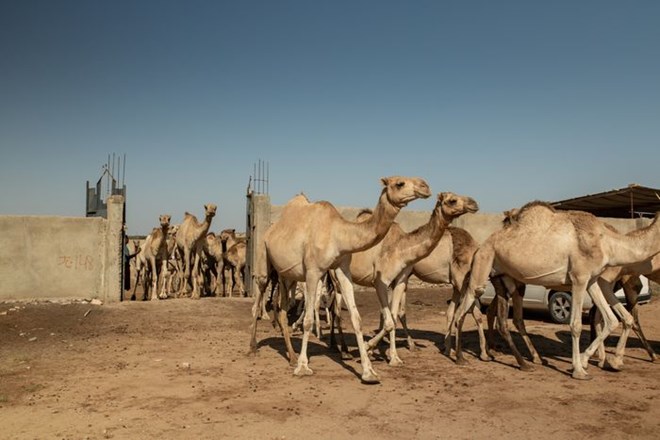
Thursday November 17, 2022
By Michael M. Phillips
Photographs by Mustafa Saeed for The Wall Street Journal
Mohamed Isaaq grew tired of office life in Canada, so he returned to his Somaliland birthplace and took up an ancient trade

Mohamed Isaaq at his camel farm outside Hargeisa, Somaliland.
GADHYAGOOL, Somaliland—“By Allah, miserable would always be the man who owns no camels,” wrote the Somali poet Qawdhan Duale.
It took 78 camels but Mohamed Isaaq is no longer miserable.
In a reversal of the usual way of things, Mr. Isaaq has fled the stress of city life in the West to become a camel herder in the drought-stricken scrublands of eastern Africa.
After decades working as a computer network administrator in Ottawa, his life now echoes the nomadic ways of his father, his grandfather, his great grandfather and so on, going back some 15 generations.
He’s not in it for the money. On an average day he earns $150 selling camel’s milk, before paying his camelhands, his delivery driver and other expenses.
“What’s important,” says Mr. Isaaq, “is happiness.”
Some two million people born in Somalia or Somaliland—a self-declared independent state within Somalia’s internationally recognized borders—have fled war and hunger there over the past 35 years, many seeking a secure livelihood and political stability in the U.S., Canada and Europe.
Uncounted thousands have taken their earnings from Minneapolis, London, Toronto and other Somali enclaves in the West and returned home to build hotels, open stores or serve in government. But Mr. Isaaq is one of very few who have gone all the way home, back to the herds.
“The nomad life is not easy,” he admits. But “this is our heritage.”

Mr. Isaaq and some of his camels.
Mr. Isaaq is 53 years old, but looks much younger than his camel-herding peers, who have spent lifetimes in the bush. He worries about sunburn, and his nickname—most Somali men have them—is Mawlid, which means Babyface. He herds in a Ralph Lauren polo shirt and New Balance sneakers, simultaneously propping sunglasses and reading glasses atop his head.
He was 19 in 1988 when forces loyal to Somalia’s then-dictator, Mohamed Siad Barre, bombed Somaliland’s capital, Hargeisa, into rubble.
Mr. Isaaq’s parents could no longer care for him. So he walked to Ethiopia. He made his way to Canada, received refugee status, became a citizen and earned a certificate in computer network administration
He spent three decades in Ottawa, married and had three children. He was grateful to Canada for taking him in.
But the office grind wore on him. “The people are like a machine,” he says. He developed poor blood circulation, worsened by the cold and humidity. There was a messy divorce.
Mr. Isaaq’s grandfather was fully nomadic, settling in one spot while the forage held out, then packing up in search of greener pastures. Mr. Isaaq herded with his own father from the age of five.
In Ottawa he felt the pull of the old Somali ways, and he believed the dry weather and a diet heavy in camel’s milk would restore his health.

Mr. Isaaq sips fresh camel’s milk from a watertight woven basket.
In 2020, he moved back to Somaliland and married Zamzam Hassan, paying her family a bride price of 25 camels for her hand.
His opening bid to Ms. Hassan was that they live in Faraweyne District, a semi-arid expanse of scrubby bush, aloe and sorghum fields on the Ethiopian border. “In the West, one day you can be rich and the next day you can be poor and sick,” he told her. “I want to move to the bush and have two camels.”
That was a non-starter for the 39-year-old Ms. Hassan.
She had grown up in Mogadishu, Somalia’s capital, and earned her graduate degree in business in Hargeisa. She works for a Norwegian aid agency.
She emphatically did not picture herself living in a village of a few dozen corrugated metal shacks and no flushing toilets, or, worse yet, camping out with the herds.
But she saw how much her new husband yearned for such a life.
“I really wanted to know what he loves so much, because I didn’t have that growing up,” Ms. Hassan says.
So she counter-offered: How about buying a couple-dozen camels and keeping them on some investment property she owned on the outskirts of Hargeisa? He could drink his fill of camel’s milk and walk the bush with his animals to his heart’s content.
“We can keep our house and we can keep the camels,” she says.

At his new wife’s insistence, Mr. Isaaq also has a house in Hargeisa.

Young camels at the farm.
Despite his nostalgia, Mr. Isaaq knew little about the camel industry. So he and Ms. Hassan read camel-herding books, including Axmed Cali Abokor’s 1986 “Suugaanta Geela” (Camel Literature), and Farah and Fischer’s “Milk and Meat from the Camel: Handbook on Products and Processing.” They watched an Emirati documentary called “Camelicious.”
Adult camels fetch $1,000 to $2,000. Mr. Isaaq acquired huge ones from Baidoa, a city in Somalia. Al-Shabaab, al Qaeda’s local affiliate, operates a shadow government in parts of Somalia, and his camel broker paid militants $300 in extortionary taxes to get 26 animals to Somaliland, which is far more stable than Somalia.
He keeps 71 camels at the Hargeisa farm, and seven more with his cousin Mokhtar Isaaq in Faraweyne District. Mohamed spends a few days a month herding with Mokhtar, sleeping on the ground in makeshift enclosures of sharp-spiked branches to fend off hyenas and jackals.
Mokhtar and Mohamed grew up playing together in Faraweyne, where Mohamed’s father and grandfather herded. But their paths diverged sharply.
Mokhtar, 53, migrates with his 30-camel herd between the villages of Gadhyagool and Xidhinta, even wandering into Ethiopia during desperate times.
He never thought himself clever enough to have taken a chance on the West, the way Mohamed did. Nor can he imagine a better life than the one he has.
“When people come home, it’s not strange,” Mokhtar says, sipping sugary tea with camel’s milk under a pink pepper tree. “When people leave—that’s strange.”

A market in Hargeisa.
Mohamed is frustrated by his cousin’s lack of ambition, and his habit of wasting his afternoons and income on qat, an addictive stimulant chewed widely in the Horn of Africa. “It’s a bad habit,” Mokhtar says sheepishly.
But Mohamed loves the rhythm of life with the herd—solitary walks across rock-and-sand terrain, meals of boiled goat and rice, nights under the stars. The sense of knowing where he belongs in the larger scheme of things.
When he runs into a herder with 50 camels from Ethiopia, where rains have failed and forage is scarce, Mohamed quickly figures out they’re related five generations back. He can map his relations back 21 grandfathers. Somalis, he says, like to know who they’re dealing with.
“If you don’t know their tribal tree, who are they?” he asks.
Mohamed’s paternal grandfather watered his camels at the Dhaboolaq River, the same spot he and Mokhtar now bring their own animals.
“Of all the people who went overseas, you’re the only who came back here,” the Dhaboolaq village chief, Ahmed Ibrahim, tells Mohamed.
Each morning and evening back in Hargeisa, Mohamed‘s farmhands milk the camels standing on one leg while balancing a watertight woven milk basket on the other thigh. The herd produces 60 liters a day, which he sells to roadside camel’s milk stands and a hotel restaurant for $2.50 each.
The stresses of herding are different from the computer viruses and user errors he encountered in his IT job in Canada.
Earlier last month, one farmhand accused another of embezzling camel’s milk, in the hopes of getting the man fired and his own kinsman hired. The two came to blows.
Four camels escaped for 10 days after their handler abandoned the herd to buy qat.
Still, Mohamed’s glad to be home again.
“It’s kind of a relief,” he says of his new life. “It’s like I was hurting and took a Tylenol.”

Mr. Isaaq has assembled a herd of 78 camels.